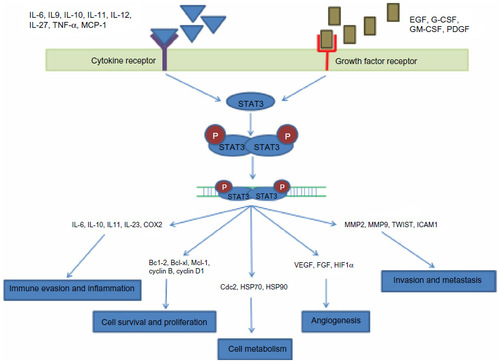Figures & data
Figure 1 Schematic model for the role of STAT3 pathway in various physiological processes.
Notes: After binding to cytokines or growth factor, their receptors get activated and transmit a signal across the cell membrane, which leads to phosphorylation, dimerization, and nuclear translocation of STAT3. This response initiates different cellular and physiological processes. Inflammation results due to differential expression of various cytokines and enzymes such as COX2. Cell survival and proliferation is stimulated by induction of antiapoptotic genes such as Bcl-xl and Bcl-2; upregulation of cyclin B and cyclin D1. Metabolism is affected by altered expression of HSP70, HSP90, and Cdc2. Tumor related functions such as angiogenesis, invasion, and metastasis are triggered by activated STAT3 by regulating the expression of VEGF, FGF, HIF1α, MMP2, MMP9, TWIST, and ICAM1.
Abbreviations: COX2, cyclooxygenase 2; EGF, epidermal growth factor; FGF, fibroblast growth factor; G-CSF, granulocyte colony-stimulating factor; GM-CSF, granulocyte-macrophage colony-stimulating factor; IL, interleukin; MCP-1, monocyte chemotactic protein-1; P, phosphate; PDGF, platelet-derived growth factor; STAT3, signal transducer and activator of transcription 3; TNF-α, tumor necrosis factor α; VEGF, vascular endothelial growth factor.
Abbreviations: COX2, cyclooxygenase 2; EGF, epidermal growth factor; FGF, fibroblast growth factor; G-CSF, granulocyte colony-stimulating factor; GM-CSF, granulocyte-macrophage colony-stimulating factor; IL, interleukin; MCP-1, monocyte chemotactic protein-1; P, phosphate; PDGF, platelet-derived growth factor; STAT3, signal transducer and activator of transcription 3; TNF-α, tumor necrosis factor α; VEGF, vascular endothelial growth factor.

Table 1 Different agents which directly or indirectly inhibit STAT3 activity in pancreatic cancer cell lines
